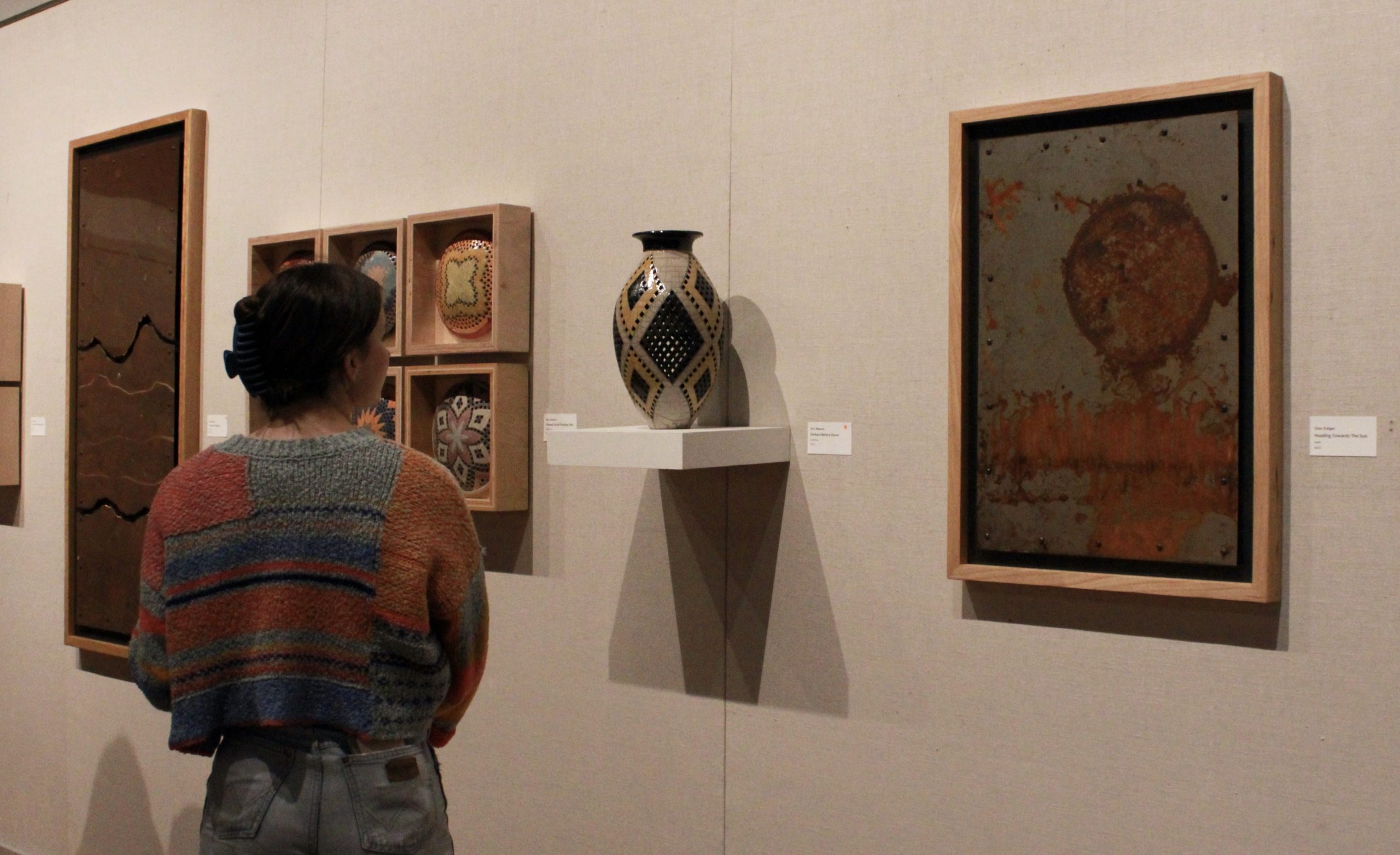By TAYLOR THOMPSON
Tiger Media Network
Last Thursday, the “Elemental” exhibition hosted by the Hays Art Center, came to a conclusion with a gallery talk by two featured artists. The gallery showcased raku-fired pottery by Eric Stearns and environmental metal works by Glen Ediger. This event served as an opportunity for the public to understand their personal career journies, their connection to the Hays community, as well as the inspiration behind their creative works.
Stearns grew up on a farm in the north side of Nebraska and is the first person from his family to attend college. After receiving a full-tuition scholarship for soccer at Doane College, he earned his BFA there. After graduation, he applied for the Master of Art program at FHSU in 2008. It was during his time here he learned the art of raku from his mentors, that would shape his artistic process.
“During his time at Fort Hays, that’s when this process was created, invented, when it evolved, and when it just manifested itself. It was here during those three years that Eric was working on his MFA. So I’d like to thank we’ve all had a hand, but Eric gets most of the credit,” said Hays Arts Council Executive Director Brenda Meder.
While he studied at FHSU, Stearns was also teaching students during the day. He would eventually find that he had a passion for teaching artists.
“My main goal is teaching and educating the upcoming artist. That’s my goal. I kind of put my artwork to the back because I focus more on the students, and that’s my goal to see students succeed,” Stearns said.
In his personal works, he mixes mathematics with the raku firing process to create dynamic patterns.
“This is where the math teacher comes in. Vertical versus horizontal, odds and even numbers, I know what patterns work,” he said. “It’s a long process, I am playing with fire. I am playing with smoke.”
He also says that the key to his works is the color, which are all handmade. It was due to shipping difficulties during COVID-19 that he was able to develop the process for his glaze colors.
“A lot of my glazes came from Spectrum, which is a Canadian-based glaze company. They couldn’t ship them to me, which is probably the best thing because I started making my own glaze,” he said.
Stearns is currently a professor at Doane University and has since praised the FHSU art program for their mentorship, with a few of his pursuing their MFA here too.
“A lot of my students get to go to Fort Hays or have even stepped into Fort Hays. We’ve got up to five since I’ve been teaching. And it’s funny that now all my faculty in my department are from Fort Hays. So Fort Hays has a great thing going on,” he said.
Ediger eventually partnered with Stearns for the Elemental exhibit. After receiving a call from the Hays Art Council for interest in his work, he worked alongside Stearns to create a beautiful gallery.
Like Stearns, he grew up on a farm but wanted to attend college. After finishing his studies at K-State, he would do consulting, freelance work, and product design for notable companies like NASA. He has patented over 130 inventions and has since retired from Vorado Air as a designer and engineer.
His background in industrial design would help him create a new genre he calls “environmental exposure.” He was inspired by rusting junk that had left impressions on an old car. He turned this natural decay into a unique art style. This art form is a natural process in which rain, snow, and sun become exposed on metal and wood mediums.
“It’s like a photographer setting up a studio setting. I know what I’m gonna photograph, but then the chemical phase is the environment in my case. So that’s how these images are created, and I don’t know what I’m gonna get,” Ediger said.
He says that the most important part is the presentation, which would separate it from folk art and fine art. For the framing, he uses reclaimed wood for an industrial aesthetic.
“I always try to have a true craftsman look in the wood, so it doesn’t look folksy, it looks finished,” he said.
Overall, Ediger has enjoyed the vibrant art community of Hays and has also praised the FHSU art program.
“I’m quite surprised with the town of Hays and its interest in the arts. I thought it would be an agricultural town and not a university town, which is always up in the antes for being interested in the arts. But that’s a big part of it, and it’s obviously a very strong art program,” he said.
While both artists have ended their exhibition l in Hays, more information about their process and their portfolios can be found below.













